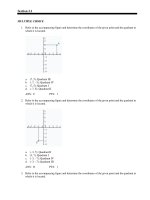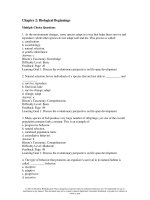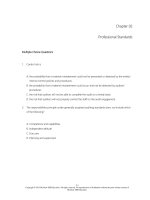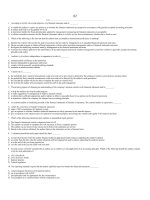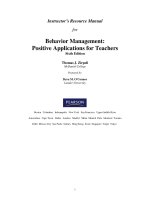Customer service skills for success 6th edition lucas test bank
Bạn đang xem bản rút gọn của tài liệu. Xem và tải ngay bản đầy đủ của tài liệu tại đây (305.58 KB, 45 trang )
Chapter 02
Contributing to the Service Culture
True / False Questions
1.
The service culture in every organization is identical.
True
2.
False
Any policy, procedure, action, or inaction on the part of an organization contributes to its service
culture.
True
3.
False
Companies that are customer-centric typically view customers from the standpoint of what
company products or services they use.
True
4.
False
In the past, a company's primary approach to attract and hold customers was to continually make
changes to its product and service lines.
True
5.
False
Customer-centric organizations have realized that it is cheaper to attract new customers than to
try and retain their current customers.
True
6.
False
A company's mission is generally driven from the top of the organization.
True
False
2-1
Copyright © 2015 McGraw-Hill Education. All rights reserved. No reproduction or distribution without the prior written consent of
McGraw-Hill Education.
7.
Mission statements should always tie back to the vision statement and should be incorporated into
the infrastructure and service culture of an organization.
True
8.
Employee expectations are perceptions about positive and negative aspects of the workplace.
True
9.
False
False
For any goal to be attained, it must be believable to the people who will strive to reach it and to
the supervisors or team leaders who will monitor it.
True
False
10. Employees should always share their organization's internal problems with the customers.
True
False
11. A sole proprietorship is a one-owner business.
True
False
12. The return policy of an organization is a gauge customers use to determine where they will spend
their time and money.
True
False
13. Protégés are individuals in an organization who dedicate time and effort to befriend and assist
others.
True
False
14. An organization should periodically conduct an inspection of its systems and practices in order to
better serve customers and to be competitive in a global service economy.
True
False
2-2
Copyright © 2015 McGraw-Hill Education. All rights reserved. No reproduction or distribution without the prior written consent of
McGraw-Hill Education.
15. The service delivery system of an organization includes having customers deal with the
organization's internal policies, practices, or politics.
True
False
16. The type of delivery system used by organizations to serve customers is not important.
True
False
17. In a direct contact environment, customers interact directly with people.
True
False
18. By outsourcing jobs to a third party, companies can save money by reducing health benefits or
retirement payments.
True
False
19. Employees should always focus on taking a one-time service or sales opportunity approach
instead of developing an ongoing relationship with customers.
True
False
20. In order to demonstrate strong support for their company, frontline employees or supervisors
should always use "they" language when dealing with customers.
True
False
21. A service professional should work with customers' interest in mind to promote a positive service
culture.
True
False
22. An organization that is committed to providing excellent customer service encourages open
communication between frontline employees and all levels of management.
True
False
2-3
Copyright © 2015 McGraw-Hill Education. All rights reserved. No reproduction or distribution without the prior written consent of
McGraw-Hill Education.
23. Typically, in organizations that demonstrate a strong commitment to customer service, the status
quo is acceptable.
True
False
24. Generally, most customers want the transactions to be quick; hence, they do not expect
pleasantries such as "please" and "thank you."
True
False
25. If frontline employees are angry because of a policy, procedure, management, or a customer, they
must always communicate their frustrations or pressures with that customer.
True
False
Multiple Choice Questions
26. Which of the following statements is true of a top down-oriented organization?
A. Customers are at the top of the organization's structure.
B. It typically focuses on individual needs of customers rather than its products.
C. It typically views the senior management as a final element or afterthought.
D. Upper management is at the top of the hierarchy.
2-4
Copyright © 2015 McGraw-Hill Education. All rights reserved. No reproduction or distribution without the prior written consent of
McGraw-Hill Education.
27. Which of the following statements is true of successful organizations?
A. The mission and vision statements of these organizations are completely different.
B. They typically view customers from the standpoint of what company products or services they
use.
C. The members of the upper management make themselves clearly visible to front-line
employees.
D. They realize that it is cheaper to continually attract new customers than to retain current
customers.
28. In an organization, _____ are the task assignments that service providers assume.
A. service delivery systems
B. customer expectations
C. employee roles
D. value chain activities
29. Which of the following characteristics is included in RUMBA?
A. Abstract
B. Understandable
C. Measureless
D. Rigid
30. In a purely customer-focused environment, service measurement is typically in terms of the:
A. employee turnover.
B. number of products manufactured.
C. potential sales.
D. number of customer complaints.
2-5
Copyright © 2015 McGraw-Hill Education. All rights reserved. No reproduction or distribution without the prior written consent of
McGraw-Hill Education.
31. Managers should always ensure that employees:
A. focus on attracting new customers rather than retaining current customers.
B. communicate the internal problems of the organization to customers.
C. are given assignments that tie in directly with the ultimate purpose or mission and overall values
or beliefs of the organization.
D. focus on taking a one-time service or sales opportunity approach instead of developing an
ongoing relationship with customers.
32. Emma is the manager of a small beauty salon. She deals with different kinds of customers and has
to ensure that the customer needs are identified and satisfied. To develop an effective customer
service, she should:
A. always use "they" language when dealing with customers and hide behind "company policy"
when handling customer problems.
B. continually strive to gain new knowledge and skills and deliver the level of service equal to that
offered by established salons.
C. focus on taking a one-time service or sales opportunity approach instead of developing an
ongoing relationship with customers.
D. exclude the information collected from customer feedback surveys when measuring the service
performance of her salon.
33. Retail and service organizations should:
A. focus on attracting new customers instead of trying to retain current customers.
B. communicate their internal problems to customers.
C. establish policies and procedures that are flexible.
D. respond to customer complaints using "company policy" as an excuse.
2-6
Copyright © 2015 McGraw-Hill Education. All rights reserved. No reproduction or distribution without the prior written consent of
McGraw-Hill Education.
34. Which of the following approaches helps companies develop an effective organizational culture?
A. Companies should recognize, appreciate, and regularly reward the performance of their
employees.
B. Companies should always view customers from the standpoint of what company products or
services they use.
C. Companies should develop mission statements that are completely different from the vision
statement.
D. Companies should ensure that employee roles are contrary to the overall values or beliefs of
the organization.
35. _____ is used to describe the giving of decision-making and problem-resolution authority to lowerlevel employees in an organization.
A. Micromanagement
B. Empowerment
C. Centralization
D. Totalitarianism
36. Empowerment:
A. makes service representatives feel like they have no say in the important decisions of an
organization.
B. restricts on-the-spot responsiveness to the customer.
C. requires frontline employees in an organization to get permission from their managers before
they serve a customer.
D. is an intangible way that service organizations reward employees.
2-7
Copyright © 2015 McGraw-Hill Education. All rights reserved. No reproduction or distribution without the prior written consent of
McGraw-Hill Education.
37. Which of the following is the first step that an organization should take in creating or redefining its
service environment?
A. Empowering its employees in order to better serve customers
B. Making sure it knows who its customers really are
C. Conducting an inspection of its systems and practices
D. Reviewing the manner in which external customer needs are addressed
38. The first step a company should take in creating or redefining its service environment is to:
A. decide where the company is now and where it needs to be in order to better serve customers.
B. review the manner in which the internal and external customer needs are addressed.
C. create a plan to attract and hold its potential customers.
D. conduct an inspection of its service and product delivery mechanisms.
39. To ensure the success of an organization's customer service, a service professional should:
A. continually reevaluate what he/she does on a daily basis when dealing with customers.
B. communicate the organization's internal policies, practices, or politics to customers.
C. focus on attracting new customers rather than trying to retain existing customers.
D. always use "they" language when dealing with customers.
40. _____ is defined as a group of processes in an organization that make service seamless to
customers by ensuring that things work properly and the customer is satisfied.
A. Customer-friendly system
B. Employee empowerment
C. Product development
D. Management information system
2-8
Copyright © 2015 McGraw-Hill Education. All rights reserved. No reproduction or distribution without the prior written consent of
McGraw-Hill Education.
41. The means by which an organization effectively gets its products and services to customers is
known as:
A. outsourcing.
B. service delivery systems.
C. micromanagement.
D. service measurement.
42. To maintain an efficient service delivery system, an organization should always:
A. ensure that frontline employees cannot take decisions without the permission of their
supervisors.
B. ensure that customers do not have to deal with the internal policies, practices, and politics.
C. encourage its managers and frontline employees to use "they" language when dealing with
customers.
D. view customers from the standpoint of what company products or services they use.
43. An indirect delivery system:
A. involves face-to-face interaction between employees and customers.
B. offers a hands-off self-service approach to customers.
C. cannot provide follow-up support to customers.
D. is viewed as a more caring customer service approach than a direct delivery system.
44. A benefit for an organization that outsources its noncore positions is that:
A. the long-term employee expertise of the organization is retained.
B. the organization's reputation in the eyes of the local citizens improves significantly.
C. the loyalty of the remaining employees in the organization increases.
D. the need to purchase and update computers and related equipment is eliminated.
2-9
Copyright © 2015 McGraw-Hill Education. All rights reserved. No reproduction or distribution without the prior written consent of
McGraw-Hill Education.
45. Which of the following statements is a disadvantage for a company that outsources jobs?
A. The need to purchase and update computers and related equipment increases substantially.
B. The potential to groom and hire from within an enculturated workforce decreases.
C. The work force size within the company increases, thereby increasing its salary budget.
D. The company's contribution to employee health benefits, retirement, and 401(k) payments
increases.
46. Internal employees or external consultants who pose as customers in on-site visits, over the
telephone, or online to determine how well customers are being served are known as:
A. mystery shoppers.
B. lobbyists.
C. jobbers.
D. category captains.
47. To promote a positive service culture, customer service professionals should always _____.
A. view vendors and suppliers as salespeople whose only purpose is to serve them
B. focus on taking a one-time service or sales opportunity approach instead of developing an
ongoing relationship with customers
C. be well versed in the many facets of their organization and its operation, related industry topics,
and the competition
D. use "they" language when dealing with customers
2-10
Copyright © 2015 McGraw-Hill Education. All rights reserved. No reproduction or distribution without the prior written consent of
McGraw-Hill Education.
48. Daniel, a customer service executive, has received a call from Mrs. Karen Lynn, a customer,
complaining about a problem with her refrigerator. Mrs. Lynn wants to get the refrigerator fixed at
no additional cost. However, the warranty period for the appliance has expired. In this scenario,
which of the following responses will demonstrate Daniel's commitment to customer service?
A. "Mrs. Lynn, I cannot help you. The company policy states that customers have to bear the cost
of repairs after the warranty period has expired."
B. "Mrs. Lynn, let me transfer your call to the sales department. They will brief you about the new
products that are being offered this month."
C. "Mrs. Lynn, I've inquired about request, but the manager has said that the company cannot
incur the cost of repairing your refrigerator."
D. "Mrs. Lynn, what I can do to resolve this problem is to offer you a thirty percent discount on the
repair costs and a two-year warranty on your appliance."
49. Which of the following is a characteristic of organizations that are highly committed to customer
service?
A. They discourage employee empowerment.
B. They readily accept status quo.
C. They benchmark the successful practices of competitors.
D. They restrict communication between frontline employees and all levels of management.
50. Which of the following guidelines should customer service professionals follow to meet the
expectations of customers?
A. Service professionals should always use "they" language when dealing with customers.
B. Service professionals should involve customers in situations that are out of their control.
C. Service professionals should strive to mask their feelings of anger, frustration, and pressure from
customers.
D. Service professionals should focus on attracting new customers rather than trying to retain
existing customers.
2-11
Copyright © 2015 McGraw-Hill Education. All rights reserved. No reproduction or distribution without the prior written consent of
McGraw-Hill Education.
Short Answer Questions
51. From a customer's perspective, what are the skills and qualifications that service employees in both
large and small organizations must possess? What may happen if service employees fail to possess
these skills?
52. Explain how a mentor can assist new employees.
53. Explain how empowerment helps develop an effective service culture?
2-12
Copyright © 2015 McGraw-Hill Education. All rights reserved. No reproduction or distribution without the prior written consent of
McGraw-Hill Education.
54. What are the two types of delivery systems? Why is there a delicate balance in selecting a service
delivery system?
55. List the twelve strategies for promoting a positive service culture.
2-13
Copyright © 2015 McGraw-Hill Education. All rights reserved. No reproduction or distribution without the prior written consent of
McGraw-Hill Education.
Chapter 02 Contributing to the Service Culture Answer Key
True / False Questions
1.
The service culture in every organization is identical.
(p. 45)
FALSE
The service culture is different for each organization. No two organizations operate in the same
manner, have the same focus, or provide management that accomplishes the same results.
AACSB: Analytic
Accessibility: Keyboard Navigation
Blooms: Remember
Learning Objective: 02-01 Explain the elements of a successful service culture.
Level of Difficulty: 1 Easy
Topic: Defining a Service Culture
2.
Any policy, procedure, action, or inaction on the part of an organization contributes to its
(p. 45)
service culture.
TRUE
A service culture includes the values, beliefs, norms, rituals, and practices of a group or
organization. Any policy, procedure, action, or inaction on the part of an organization
contributes to its service culture.
AACSB: Analytic
Accessibility: Keyboard Navigation
Blooms: Remember
Learning Objective: 02-01 Explain the elements of a successful service culture.
Level of Difficulty: 1 Easy
Topic: Defining a Service Culture
2-14
Copyright © 2015 McGraw-Hill Education. All rights reserved. No reproduction or distribution without the prior written consent of
McGraw-Hill Education.
3.
Companies that are customer-centric typically view customers from the standpoint of what
(p. 46)
company products or services they use.
FALSE
Companies that are top-down-oriented (with upper management at the top of their hierarchy
and customers as a final element or afterthought) or product-centered and view customers
from the standpoint of what company products or services they use. On the contrary,
organizations that are customer-centered or customer-centric focus on individual needs.
AACSB: Analytic
Accessibility: Keyboard Navigation
Blooms: Understand
Learning Objective: 02-01 Explain the elements of a successful service culture.
Level of Difficulty: 2 Medium
Topic: Defining a Service Culture
4.
In the past, a company's primary approach to attract and hold customers was to continually
(p. 46)
make changes to its product and service lines.
TRUE
In the past, organizations were continually making changes to their product and service lines to
try to attract and hold customers. Often this has been their primary approach to customer
satisfaction.
AACSB: Analytic
Accessibility: Keyboard Navigation
Blooms: Understand
Learning Objective: 02-01 Explain the elements of a successful service culture.
Level of Difficulty: 2 Medium
Topic: Defining a Service Culture
2-15
Copyright © 2015 McGraw-Hill Education. All rights reserved. No reproduction or distribution without the prior written consent of
McGraw-Hill Education.
5.
Customer-centric organizations have realized that it is cheaper to attract new customers than to
(p. 46)
try and retain their current customers.
FALSE
Many major organizations have become more customer-centric and stress relationships with
customers. They realize that it is cheaper, and smarter, to keep current customers rather than
subscribe to a revolving-door approach of continually trying to attract new customers to
replace the ones that they lost to competitors.
AACSB: Analytic
Accessibility: Keyboard Navigation
Blooms: Understand
Learning Objective: 02-01 Explain the elements of a successful service culture.
Level of Difficulty: 2 Medium
Topic: Defining a Service Culture
6.
A company's mission is generally driven from the top of the organization.
(p. 47)
TRUE
Generally, an organization's approach to business, its mission or its service philosophy, is driven
from the top of the organization. Upper management, including members of the board of
directors, when appropriate, sets the vision or tone and direction of the organization.
AACSB: Analytic
Accessibility: Keyboard Navigation
Blooms: Remember
Learning Objective: 02-01 Explain the elements of a successful service culture.
Level of Difficulty: 1 Easy
Topic: Defining a Service Culture
2-16
Copyright © 2015 McGraw-Hill Education. All rights reserved. No reproduction or distribution without the prior written consent of
McGraw-Hill Education.
7.
Mission statements should always tie back to the vision statement and should be incorporated
(p. 48)
into the infrastructure and service culture of an organization.
TRUE
Most successful organizations have written mission and vision statements that answer the
questions of "What does the organization do?" and "Why does the organization exist?" Mission
statements should always tie back to the vision statement and should be incorporated into the
infrastructure (e.g., HR policies and procedures) and service culture of an organization.
AACSB: Analytic
Accessibility: Keyboard Navigation
Blooms: Understand
Learning Objective: 02-01 Explain the elements of a successful service culture.
Level of Difficulty: 2 Medium
Topic: Defining a Service Culture
8.
Employee expectations are perceptions about positive and negative aspects of the workplace.
(p. 49)
TRUE
Employee expectations are perceptions about positive and negative aspects of the workplace.
AACSB: Analytic
Accessibility: Keyboard Navigation
Blooms: Remember
Learning Objective: 02-01 Explain the elements of a successful service culture.
Level of Difficulty: 1 Easy
Topic: Defining a Service Culture
2-17
Copyright © 2015 McGraw-Hill Education. All rights reserved. No reproduction or distribution without the prior written consent of
McGraw-Hill Education.
9.
For any goal to be attained, it must be believable to the people who will strive to reach it and to
(p. 51)
the supervisors or team leaders who will monitor it.
TRUE
For any goal to be attained, it must be believable to the people who will strive to reach it and to
the supervisors or team leaders who will monitor it.
AACSB: Analytic
Accessibility: Keyboard Navigation
Blooms: Remember
Learning Objective: 02-01 Explain the elements of a successful service culture.
Level of Difficulty: 1 Easy
Topic: Defining a Service Culture
10.
Employees should always share their organization's internal problems with the customers.
(p. 52)
FALSE
Employees must ensure that service continues to be delivered to customers in a seamless
fashion. Customers should not hear about internal problems. They should be able to expect
that the products and services they paid for are delivered when promised, in the manner
agreed upon, and without inconvenience to them.
AACSB: Analytic
Accessibility: Keyboard Navigation
Blooms: Understand
Learning Objective: 02-01 Explain the elements of a successful service culture.
Level of Difficulty: 2 Medium
Topic: Defining a Service Culture
2-18
Copyright © 2015 McGraw-Hill Education. All rights reserved. No reproduction or distribution without the prior written consent of
McGraw-Hill Education.
11.
A sole proprietorship is a one-owner business.
(p. 53)
TRUE
A sole proprietorship is a one-owner business. The growth of sole proprietorships and small
businesses has an upside in that they provide more choices for customers.
AACSB: Analytic
Accessibility: Keyboard Navigation
Blooms: Remember
Learning Objective: 02-01 Explain the elements of a successful service culture.
Level of Difficulty: 1 Easy
Topic: Defining a Service Culture
12.
The return policy of an organization is a gauge customers use to determine where they will
(p. 56)
spend their time and money.
TRUE
An effective return policy is part of the overall service process. In addition to service received,
the return policy of an organization is another gauge customers use to determine where they
will spend their time and money.
AACSB: Analytic
Accessibility: Keyboard Navigation
Blooms: Understand
Learning Objective: 02-01 Explain the elements of a successful service culture.
Level of Difficulty: 2 Medium
Topic: Defining a Service Culture
2-19
Copyright © 2015 McGraw-Hill Education. All rights reserved. No reproduction or distribution without the prior written consent of
McGraw-Hill Education.
13.
Protégés are individuals in an organization who dedicate time and effort to befriend and assist
(p. 61)
others.
FALSE
Mentors are individuals who dedicate time and effort to befriend and assist others. In an
organization, they are typically people with a lot of knowledge, experience, skills, and initiative,
and have a large personal and professional network established. A protégé is typically a lessexperienced recipient of the efforts of the mentor.
AACSB: Analytic
Accessibility: Keyboard Navigation
Blooms: Remember
Learning Objective: 02-01 Explain the elements of a successful service culture.
Level of Difficulty: 1 Easy
Topic: Defining a Service Culture
14.
An organization should periodically conduct an inspection of its systems and practices in order
(p. 64)
to better serve customers and to be competitive in a global service economy.
TRUE
An organization should periodically conduct an inspection of its systems and practices to
decide where the company is now and where it needs to be in order to better serve customers
and to be competitive in a global service economy.
AACSB: Analytic
Accessibility: Keyboard Navigation
Blooms: Remember
Learning Objective: 02-02 Define a service strategy.
Level of Difficulty: 1 Easy
Topic: Establishing a Service Strategy
2-20
Copyright © 2015 McGraw-Hill Education. All rights reserved. No reproduction or distribution without the prior written consent of
McGraw-Hill Education.
15.
The service delivery system of an organization includes having customers deal with the
(p. 66)
organization's internal policies, practices, or politics.
FALSE
Customers should not have to deal with internal policies, practices, or politics. They should be
able to contact the service provider; get the information they need; make a buying decision,
where appropriate; and have the products or services they have selected flawlessly delivered in
a timely, professional manner.
AACSB: Analytic
Accessibility: Keyboard Navigation
Blooms: Remember
Learning Objective: 02-03 Recognize customer-friendly systems.
Level of Difficulty: 2 Medium
Topic: Customer-Friendly Systems
16.
The type of delivery system used by organizations to serve customers is not important.
(p. 67)
FALSE
The type of delivery system used by organizations to serve customers is important because it
affects staffing numbers, costs, technology, scheduling, and many other factors.
AACSB: Analytic
Accessibility: Keyboard Navigation
Blooms: Remember
Learning Objective: 02-03 Recognize customer-friendly systems.
Level of Difficulty: 1 Easy
Topic: Customer-Friendly Systems
2-21
Copyright © 2015 McGraw-Hill Education. All rights reserved. No reproduction or distribution without the prior written consent of
McGraw-Hill Education.
17.
In a direct contact environment, customers interact directly with people.
(p. 67)
TRUE
The major difference between the two types of service delivery systems is that in a direct
contact environment, customers interact directly with people, whereas in an indirect system
their needs are met primarily with self-service through technology (possibly integrated with the
human factor in customer contact/call centers) integrated with Internet services.
AACSB: Analytic
Accessibility: Keyboard Navigation
Blooms: Remember
Learning Objective: 02-03 Recognize customer-friendly systems.
Level of Difficulty: 1 Easy
Topic: Customer-Friendly Systems
18.
By outsourcing jobs to a third party, companies can save money by reducing health benefits or
(p. 68)
retirement payments.
TRUE
By outsourcing jobs to a third party, companies can save money by eliminating large ongoing
salaries; reducing health benefits, retirement, and 401(k) payments; avoiding the need to
purchase and update computers and related equipment and a myriad of other equipment;
increasing workforce size without necessarily doing likewise to the budget; and bringing in new,
fresh expertise, ideas, and perspectives from outside the organization.
AACSB: Analytic
Accessibility: Keyboard Navigation
Blooms: Understand
Learning Objective: 02-03 Recognize customer-friendly systems.
Level of Difficulty: 2 Medium
Topic: Customer-Friendly Systems
2-22
Copyright © 2015 McGraw-Hill Education. All rights reserved. No reproduction or distribution without the prior written consent of
McGraw-Hill Education.
19.
Employees should always focus on taking a one-time service or sales opportunity approach
(p. 72)
instead of developing an ongoing relationship with customers.
FALSE
Employees should focus on developing an ongoing relationship with customers instead of
taking a one-time service or sales opportunity approach.
AACSB: Analytic
Accessibility: Keyboard Navigation
Blooms: Understand
Learning Objective: 02-04 Implement strategies for promoting a positive service culture.
Level of Difficulty: 1 Easy
Topic: Twelve Strategies for Promoting a Positive Service Culture
20.
In order to demonstrate strong support for their company, frontline employees or supervisors
(p. 74)
should always use "they" language when dealing with customers.
FALSE
One mistake that many frontline employees and supervisors make in communications with
customers is to intentionally or unintentionally demonstrate a lack of commitment or support
for their company and a sense of powerlessness. A common way in which this occurs is with the
use of "they" language when dealing with customers.
AACSB: Analytic
Accessibility: Keyboard Navigation
Blooms: Understand
Learning Objective: 02-04 Implement strategies for promoting a positive service culture.
Level of Difficulty: 2 Medium
Topic: Twelve Strategies for Promoting a Positive Service Culture
2-23
Copyright © 2015 McGraw-Hill Education. All rights reserved. No reproduction or distribution without the prior written consent of
McGraw-Hill Education.
21.
A service professional should work with customers' interest in mind to promote a positive
(p. 74)
service culture.
TRUE
To promote a positive service culture, a service professional should work with customers'
interest in mind, treat vendors and suppliers as customers, share resources, and demonstrate
commitment.
AACSB: Analytic
Accessibility: Keyboard Navigation
Blooms: Remember
Learning Objective: 02-04 Implement strategies for promoting a positive service culture.
Level of Difficulty: 1 Easy
Topic: Twelve Strategies for Promoting a Positive Service Culture
22.
An organization that is committed to providing excellent customer service encourages open
(p. 76)
communication between frontline employees and all levels of management.
TRUE
An organization that is committed to providing excellent customer service encourages open
communication between frontline employees and all levels of management.
AACSB: Analytic
Accessibility: Keyboard Navigation
Blooms: Remember
Learning Objective: 02-05 Separate average companies from exceptional companies.
Level of Difficulty: 1 Easy
Topic: Separating Average Companies from Excellent Companies
2-24
Copyright © 2015 McGraw-Hill Education. All rights reserved. No reproduction or distribution without the prior written consent of
McGraw-Hill Education.
23.
Typically, in organizations that demonstrate a strong commitment to customer service, the
(p. 76)
status quo is acceptable.
FALSE
Typically, in organizations that demonstrate a strong commitment to customer service, the
status quo is not acceptable.
AACSB: Analytic
Accessibility: Keyboard Navigation
Blooms: Understand
Learning Objective: 02-05 Separate average companies from exceptional companies.
Level of Difficulty: 2 Medium
Topic: Separating Average Companies from Excellent Companies
24.
Generally, most customers want the transactions to be quick; hence, they do not expect
(p. 76)
pleasantries such as "please" and "thank you."
FALSE
Most customers expect certain intangible things during a service encounter, such as personal
recognition, courtesy (pleasantries such as "please" and "thank you"), timely service, and
professionalism.
AACSB: Analytic
Accessibility: Keyboard Navigation
Blooms: Remember
Learning Objective: 02-06 Identify what customers want.
Level of Difficulty: 1 Easy
Topic: What Customers Want
2-25
Copyright © 2015 McGraw-Hill Education. All rights reserved. No reproduction or distribution without the prior written consent of
McGraw-Hill Education.



